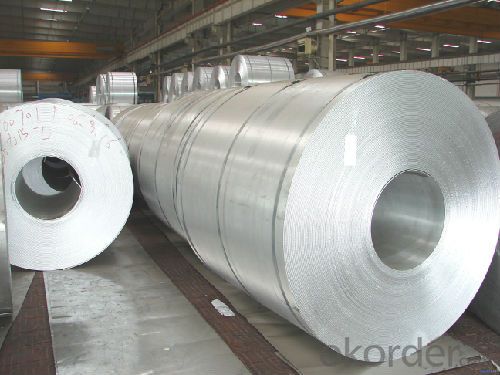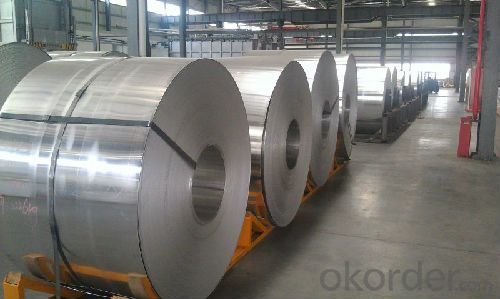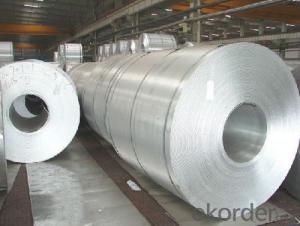Aluminum Coil AA1050,1100,3003,5753,5083,6061
- Loading Port:
- Shanghai
- Payment Terms:
- TT OR LC
- Min Order Qty:
- 5 m.t.
- Supply Capability:
- 9000 m.t./month
OKorder Service Pledge
OKorder Financial Service
You Might Also Like
Item specifice
Product Description
aluminum coil specifications:
1) Alloy :1050, 1060,1100, 3003 3004 3105 3A21 5005 5052 etc
2) Temper: O/H12/H14/H1/H18/H32/H34/H36/H38//H111/H112/H116/H321/T6/T651/T3/T351 etc
3) Thickness: 0.1mm to 6mm
4) Width:20mm to 3300mm
5)Coil weight: 100kgs to 6 tons depends on actual requirement
6)Core material: Aluminum or paper
7)Coil Inner diameter: 75mm, 150mm, 200mm, 300mm, 405mm, 505mm or as required
8) Protective film can be added

Application
Appplication:construction, roofing, decoration, lamping etc
Packaging & Shipping
Package: eye to wall or eye to the wall for aluminum coil with wood pallet (wooded case also available)

Our Services
1) Reply within 12 hours
2) Free samples provided
3) On-site production following-up
4) Loading inspection with container fixing
5)Third party inspection at your request

- Q:Are the aluminum sheets suitable for architectural applications?
- Yes, aluminum sheets are highly suitable for architectural applications. Aluminum is a versatile material that offers numerous benefits for architectural projects. It is lightweight, durable, and resistant to corrosion, making it ideal for exterior applications. Aluminum sheets can be easily shaped, formed, and manipulated to create intricate designs and structures, allowing architects to bring their creative visions to life. Additionally, aluminum is a sustainable material as it is 100% recyclable, reducing the environmental impact of architectural projects. Overall, the use of aluminum sheets in architectural applications provides both aesthetic appeal and functional durability, making it a preferred choice for architects and designers.
- Q:Are aluminum sheets suitable for structural applications?
- Yes, aluminum sheets are suitable for structural applications. Aluminum is a lightweight and strong material, making it ideal for use in various structural applications. It has a high strength-to-weight ratio, which means that it can provide significant strength while keeping the overall weight of the structure low. This characteristic makes aluminum sheets particularly suitable for applications where weight is a critical factor, such as in aerospace, automotive, and marine industries. Additionally, aluminum sheets offer excellent corrosion resistance, which is important for structures that are exposed to harsh environmental conditions or moisture. They are also highly durable and have good thermal and electrical conductivity. These properties make aluminum sheets suitable for a wide range of structural applications, including building facades, roofing, curtain walls, bridges, shipbuilding, and electrical enclosures. Moreover, aluminum sheets are easy to work with, as they can be easily cut, formed, and welded. This flexibility in fabrication allows for the creation of complex and customized structural components. Aluminum also has a natural oxide layer that provides protection against corrosion, reducing the need for additional coatings or treatments. However, it is important to consider the specific requirements and loads of each structural application before choosing aluminum sheets. While aluminum is strong, it may not be suitable for heavy-load-bearing applications where steel or other materials may be more appropriate. Proper engineering and design considerations should be taken to ensure the structural integrity and safety of the application.
- Q:I know that aluminum doesn't belong in the human body. As a canister to hold liquids which will be consumed later, is aluminum good or bad to use?
- Not really. Al in your diet is believed to be a cause of Alzheimer's disease. And putting acids (like fruit juice) in a bottle would definitely corrode the metal somewhat; water is slower but there is a taste that means that some Al is going in. Thus many (most/all?) Al bottles are lined in plastic and have plastic closures. Stainless steel with a stainless steel closure are a much better choice than Al. But they are harder to find and often more expensive. Stainless steel with polyprop. closures but not plastic lined are easier to find (but less durable; I am forever breaking off the poly tabs). Of course Al bottles are better than plastic bottles.
- Q:I have a problem when machining aluminium in my machine shop. There are times when the machines aluminium surface turns yellowish (somtimes brown). I do not know what is the main cause of the problem. Is it due to the coolant used?
- Aluminum oxides may appear in different colors depending on hydration states and other variables. Look in a CRC Handbook of Chemistry Physics if available for aluminum compounds and their colors. The colors that you see may also have as much to do with the surface finish as the color of the material on the surface. A microscopically rough surface will appear dark next to a polished surface due to light scattering. I will agree with Ling in principle, but not on details. EDS detection limits on homogeneous samples can be better than 0.1%, although not so good for elements at the light end of the detection range. Current detectors can detect chlorine (a common culprit for aluminum discoloration) at about 0.1%. Your problem with detection and one that Ling has addressed previously may be that a thin film of contamination would not be easily detected by EDS. As Ling suggests, SIMS is a good technique for detecting thin films and low concentrations. The problem with SIMS in this case may be that the detection limits are too good and the technique cannot be quantified. SIMS would detect 2 ppm of chloride and you couldn't tell for sure whether it was 2 ppm, which is probably not an issue here, or 2000 ppm, which would be significant. I would suggest x-ray photoelectron spectroscopy (ESCA or XPS) as an alternative for further study. The technique will analyze thin films (20 A) and detection limits are good enough (about 0.1%). In addition, XPS will give you information about the compounds present, e.g. whether the oxygen is aluminum oxide, aluminum hydroxide, etc. Good Luck.
- Q:how to avoid oxidation of aluminum sheet after wire drawing?
- leave it alone after wire drawing!aluminum sheet will formulate a layer of dense oxide film. So you don't need to worry about it! Don't often polish the aluminum wire, or they will be more and more slimsy, the oxide film is used for avoiding reoxidation.
- Q:Can aluminum sheets be an alternative to ceramics in certain applications?
- Yes, aluminum sheets can be an alternative to ceramics in certain applications. Aluminum sheets offer several advantages over ceramics, such as being lighter in weight, more cost-effective, and easier to shape and fabricate. They also have excellent thermal and electrical conductivity properties, making them suitable for applications where heat dissipation or electrical conduction is required. Additionally, aluminum sheets can withstand high temperatures and have good corrosion resistance. However, ceramics still have their own unique properties and strengths, such as higher hardness, better chemical resistance, and superior insulation capabilities, which might be more suitable for certain specific applications. Therefore, the suitability of aluminum sheets as an alternative to ceramics would depend on the specific requirements and conditions of the application in question.
- Q:Are aluminum sheets suitable for interior design applications?
- Aluminum sheets are an excellent choice for interior design purposes. This material is both versatile and durable, allowing for various creative uses in enhancing the aesthetics of indoor spaces. Its malleability enables easy shaping, cutting, and manipulation, resulting in unique and contemporary designs. Different finishes, such as brushed, polished, or textured, further expand the design options. One major advantage of utilizing aluminum sheets in interior design is their lightweight composition. This feature simplifies handling and installation, reducing labor and transportation expenses. Additionally, aluminum's corrosion resistance makes it perfect for environments with high humidity or moisture, such as bathrooms or kitchens. Aluminum sheets find application in various aspects of interior design, including wall cladding, ceiling panels, room dividers, furniture, and decorative elements. The ability to paint or coat them in different colors allows seamless integration into any design scheme. Furthermore, perforation or engraving can create patterns or intricate designs, adding a distinct visual appeal to the space. Moreover, aluminum is a sustainable material with high recyclability. The recycling process consumes significantly less energy compared to the production of new aluminum, making it an environmentally friendly option for interior design applications. To summarize, the versatility, durability, lightweight nature, corrosion resistance, and manipulability of aluminum sheets make them highly suitable for interior design. They offer numerous design possibilities and can be used in various applications, rendering them a popular choice among designers and architects.
- Q:I need to make an aluminum cylinder out of 1/8 6061 plate and tube. I don't have a TIG setup and was considering using Bernzomatic aluminum soldering rods. The cylinder will be pressurized from 20-60 psi. Assuming a clean job, is this pressure ok? How much pressure can the joint take? Also, although the solder does not need flux, should i use it anyway?
- Whether that weld will be OK depends on the diameter of the cylinder. The force on the weld will be equal to the operating pressure time the radius of the cylinder, with the wall opposite the weld have an equal force. Divide that force by the thickness of the weld to figure the stress. You want to have a safety factor of about 3. As the Bernzomatic has either a brass or aluminum head, which would melt at the temperatures which are required for true welding (melting metals so that they flow together), you will be performing brazing with a Bernzomatic. I cannot comment on the strength of the brazing bond. The thickness of the brazing metal deposit depends on the strength of the brazing alloy, which I also cannot comment on. 6061 will melt at 1206°, which you will not approach with the Bernzo kit. A blowout of a metal cylinder at 60 psi could be pretty ugly. I suggest that you befriend someone who has a TIG welder and get their help. A properly welded 1/8 thick cylinder could handle about 660 psi with no problem. If you create a lap joint, using an outer strip of aluminum, and then band your cylinder with stainless steel hose clamps, you will be relying upon the brazing only to provide a gas seal. The strength would come from the hose clamps. You still need to do some calculation on forces involved. A 1/2 wide stainless hose clamp will probably hold back about 240 lb. of force with a comfortable margin of safety.
- Q:Are aluminum sheets resistant to UV rays?
- Yes, aluminum sheets are generally resistant to UV rays. Aluminum has a natural oxide layer that forms on its surface, which acts as a protective barrier against UV radiation. This oxide layer helps to prevent the aluminum from corroding or degrading when exposed to sunlight. However, it is important to note that prolonged exposure to intense UV radiation can still cause some degree of fading or discoloration over time. To enhance the UV resistance of aluminum sheets, they can also be coated with protective finishes or paints that provide an additional layer of defense against UV rays.
- Q:Can the aluminum sheets be used for reflector applications?
- Yes, aluminum sheets can be used for reflector applications as they have excellent reflective properties due to their high reflectivity and low absorption of light.
1. Manufacturer Overview |
|
|---|---|
| Location | |
| Year Established | |
| Annual Output Value | |
| Main Markets | |
| Company Certifications | |
2. Manufacturer Certificates |
|
|---|---|
| a) Certification Name | |
| Range | |
| Reference | |
| Validity Period | |
3. Manufacturer Capability |
|
|---|---|
| a)Trade Capacity | |
| Nearest Port | |
| Export Percentage | |
| No.of Employees in Trade Department | |
| Language Spoken: | |
| b)Factory Information | |
| Factory Size: | |
| No. of Production Lines | |
| Contract Manufacturing | |
| Product Price Range | |
Send your message to us
Aluminum Coil AA1050,1100,3003,5753,5083,6061
- Loading Port:
- Shanghai
- Payment Terms:
- TT OR LC
- Min Order Qty:
- 5 m.t.
- Supply Capability:
- 9000 m.t./month
OKorder Service Pledge
OKorder Financial Service
Similar products
New products
Hot products
Hot Searches
Related keywords





























